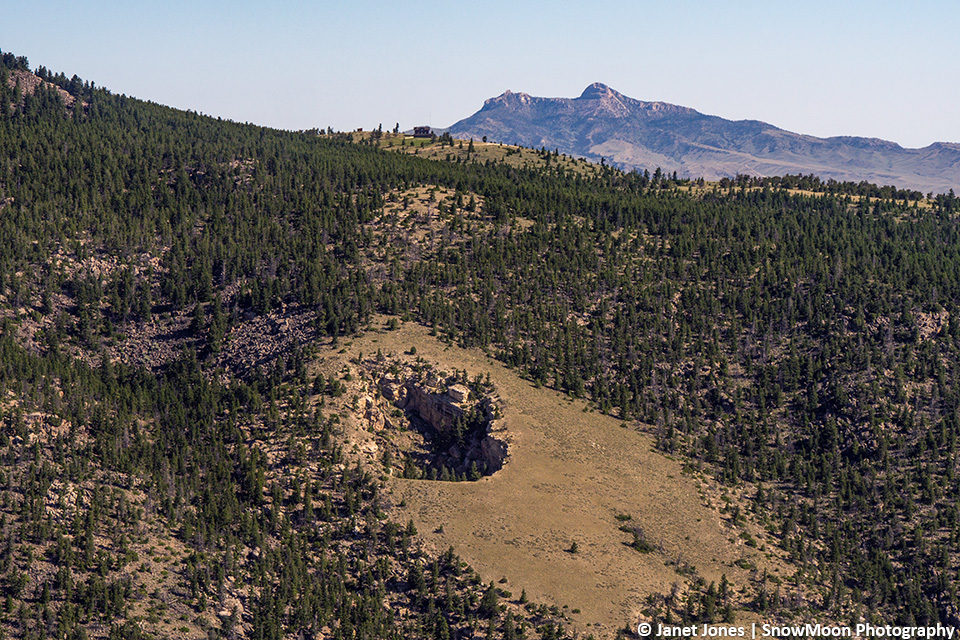The Mystique of Cedar Mountain
“It kinda spooked me,” Rode said. “I’d just finished my break in my usual spot, and as I ran around the corner, a mountain lion was standing there looking at me.” Tawny and muscular, the mountain lion immediately darted into the forest and Rode did not see it again.
For years, locals have shared tales of elusive mountain lions on Cedar, along with the lore surrounding this special mountain. Cedar Mountain and its partner, Rattlesnake Mountain, stand just west of Cody near the convergence of the North and South Forks of the Shoshone River (a spot under the Buffalo Bill Reservoir since 1910). Over millions of years, the river cut a narrow gorge between the two mountains, eventually creating steep scree fields and forbidding cliffs on Cedar Mountain’s north-facing slope. Leaving Cody by vehicle today, the route between the mountains forms a gateway to Yellowstone. Once on the other side of the North Fork Highway tunnels, travelers often feel as if they have reached an entirely different place. The Apsáalooke (Crow) even had a name for the route between Cedar and Rattlesnake. They called it “Bilialiche” or “Like a Tepee Door.”

Cedar Mountain (left) and Rattlesnake Mountain (right)
Early Maps of Cedar Mountain
On a hand-drawn map from 1808, Cedar Mountain is known as “Mah-ha-pa” and also “Spirit Mountain.” The Apsáalooke called it “Mountain of the Spirits” and used the forested north slopes for tree platform burials. During the William A. Jones engineering survey of the Absarokas in 1873, Shoshone guides mentioned to Jones that the mountain’s name was the “Mountain of Many Cedars.” Another early map shows a trail along the south slope of Cedar Mountain called “Indian Pass.”

Cedar Mountain as drawn by fur trapper George Drouillard in 1808
Discovering a Cave Network
In 1909, local hunting guide Ned Frost was hiking on Cedar Mountain with his dogs when they chased a bobcat into what Frost first thought was the cat’s den. As he followed his barking dogs into the dark opening, Frost realized that the dark space was much larger than a lair. He had discovered the extensive cave network now known as Spirit Mountain Cave.

One of the first chambers leaving the great room in Spirit Mountain Cave
In 1954, the City of Cody lobbied for local control of the cave and attempted to develop it for tourism. However, the endeavor was too expensive and the road was too rough, as it is today. Claud Brown, a local investor and contractor, also made some improvements but found the cave site difficult to develop. The federal government resumed management of the cave in 1977. Today, the entirety of the cave system is still unexplored, but geologists believe the tunnels reach at least 4,000 feet below the cave entrance.

Ned Frost, Buffalo Bill Cody, and other friends explore the newly discovered cave on the east slope of Cedar Mountain in 1909.
Crater on the South Slope
Another interesting feature on Cedar Mountain is a huge crater visible from the South Fork Highway. Locals have hiked up to the spot for generations to see the 120-yard bowl where the mountain caved in. Although it resembles a meteor strike, it is a sinkhole and is a natural geological process in areas with hydrothermal activity.

White Buffalo Statue
Unknown to many modern-day locals is a white buffalo statue on Cedar Mountain. Overlooking the Shoshone River at about 7,500 feet is a memorial to William F. Cody. Before his death, Buffalo Bill Cody had expressed his wish to be buried on Cedar, a mountain that was special to him and that overlooked the town he had helped build. But when he died in Colorado in 1917, he was buried on Lookout Mountain near Golden, Colorado. This was a controversial choice at the time, and Cody’s local friends and supporters long lamented it. In 1968, a four-day memorial celebration at both Lookout Mountain and Cedar Mountain commemorated the symbolic return of Buffalo Bill’s body to his desired burial spot on Cedar Mountain. A life-size buffalo statue, delivered by helicopter, now overlooks the city of Cody. Over the years since then, people have shot the statue and vandalized it, but several locals are currently restoring the buffalo as a charitable gesture for the community of Cody.

White Buffalo Statue on Cedar Mountain (Courtesy Photo)

Amy Hoffman
Curatorial Assistant
Cody Heritage Museum
The Cody Heritage Museum focuses on local Cody history -- and accepts family contributions of artifacts and objects that fit the areas of focus for the museum. Get in touch if you can contribute our growing collection.
